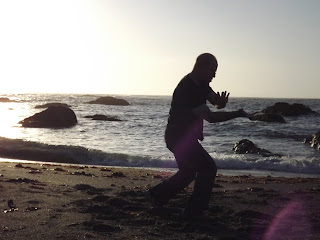Thursday, October 11, 2012
Five Swords: An analysis
Five Swords, an orange belt technique in the American Kenpo Karate System, is one of those techniques that you could talk for a long time about. I had started a series of personal journal writings on Yellow Belt techniques, and I was going to continue that originally, but then I found this great photo my wife took of me at the ocean doing Five Swords, so I thought I would talk about that for one entry here.
Five Swords teaches a multiplicity of things and it seems it can be grafted with so many other ideas and techniques. I know training at my sensei's dojo, Epperson Bros. Kenpo Karate Dojo in Chico, California, we have gone over countless grafts with this particular technique.
I know some people may be asking at this point, "What is a graft?" A graft is when you take two or more techniques and blend them together. First, you have to know the original technique and what it does and how to perform it, but then the fun part comes in where you can go through a technique and stop part way through and ask, "What if?"
Let's face it, nothing ever happens as we plan it in a dojo. We have to expect the unexpected. So, it is critical for us to recognize positions and what if scenarios so we can think on our feet. Just stop for a second and do the first move of Five Swords. How many different techniques can you move to from there. Or, if you don't like that, stop after the second move, the heel palm to the face, and ask yourself what other techniques do you recognize from there? Or, even better, how would you finish the technique? Everyone is different. They will see something different.
In this photo, my wife caught be between unloading my chop/check and loading my final chop with torque and marriage-with-gravity. There is a transition stance that you hit at this point as you position your hands for the final move. You have the choice to finish, or what if the other hand comes flying around, even by accident? Then you have the right hand in position to throw another block and extend the technique, or even start a whole new one. In Kenpo, you always want to have a backup plan. Your other hand should always be ready to meet the "what if" possibility.
Here is another thing to think about with Five Swords. Think about which power principles you are using to add power to all of your blocks, strikes, and punches. This is a technique loaded with power principles and the ability to really unload a person's potential for power just based on the body mechanics alone. You have backup mass, on the first move, torque on the second move, then there is borrowed force, more torque and marriage with gravity that follow. This is an extremely powerful tool, and powerful knowledge, to think about as you train your Kenpo.
Just like professional athletes, it is important for us to analyze our art and our motion. That is how we get better. You have to train it, but you also have to analyze it. If you like to study motion, then Kenpo may be the art for you if you are not doing it now.
I hope you have enjoyed the thoughts.
Jesse
Subscribe to:
Post Comments (Atom)

Good one, Jesse. Good point about being able to spontaneously change the technique as needed.
ReplyDelete